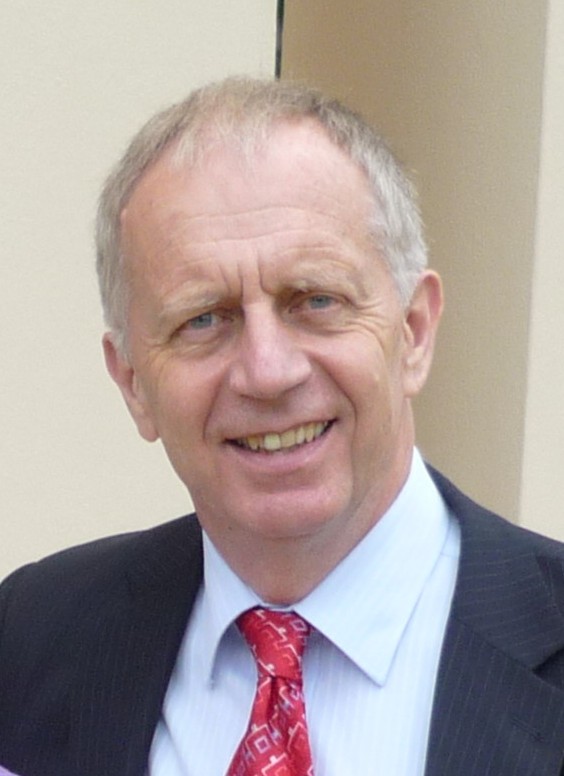
For the full listing of speakers at a symposium visit our Symposium history pages.
Quick Links - Speakers surnames in the range:
- U-Z
 Air Commodore Terry Saunders
Air Commodore Terry Saunders
2018: Big or Small: Managing Defence Projects.
An overview of the CASG project portfolio and management approaches.
Download the presentation.
Professor Shankar Sankaran
2023: Project Governance by Engineers
This presentation with Dr Tom Crow outlines the development process being undertaken by Engineers Australia to equip engineers for the governance role in projects and programs.
2022: Project Management started off as a management innovation. Can it transition to meet the sustainability challenge?
Project management practices have evolved as the discipline grew from managing defence and engineering projects to delivering information systems, supporting organizational transformation, and managing megaprojects supporting national infrastructure needs. Thus, from starting as a tactical tool, project management grew to deliver organizational and national strategies. The next challenge for project management is to support the achievement of sustainable development goals to tackle societal challenges. How can it do this? In this talk we propose a way forward for project management to contribute to global sustainability by tracing the history of projects from prehistoric times to the 21st century. We outline the development of project management using the lens of socio-technical transitions to analyse technological niches developed to advance the field, and socio-technical regimes that have supported the development of project management to adopt these technological niches to meet changes that appear at the landscape level. By analysing the history of projects and project management, we argue that the discipline has continuously evolved as a transition innovation that can meet the challenges posed by sustainable development. However, further development of project management is needed to achieve that.
2019 Walt Lipke Award Winner: A Model for Organizational Project Management and its Validation
It is important that an organization selects the right projects and carefully manages and governs them to deliver their intended benefits. This paper will describe a model for Organizational Project Management (OPM) to help organizations to do that. OPM is the integration of all project management-related activities of an organization linking strategic decisions (where the project management-related activities are to be carried out) with business decisions (portfolio management and benefits realization) with their management (program and project management) and their governance at both the strategic and project levels. This paper will describe a seven-layered model of OPM with its 22 elements – spanning from the organizational level to the individual project level – derived by the authors using academic literature and their own experience in managing projects.
Download the presentation.
See more on the Walt Lipke Award.
 Tony Scuteri.
Tony Scuteri.
2017: Introduction to Project Scheduling.
A schedule is fundamentally the decomposition of a project Work Breakdown Structure (WBS). The most widely used scheduling technique is the critical path method (CPM). CPM is mathematical analysis, which can be used on all types of projects that can be represented as a list of activities, each with an estimated duration, single or three-point. In addition, the dependencies between activities need to be defined, as do the resources required to deliver the scope of each activity. Developing and maintaining a schedule throughout the project lifecycle usually involves specific Project Management software, the data managed in the scheduling system is typically integrated with other software tools, examples of which would be an Earned Value system. The session which is educational in nature.
 Saeed Shalbafan
Saeed Shalbafan
2019 Walt Lipke Finalist: A Framework to Manage Uncertainty in Early Planning of Projects, an ICT Project
Identifying sources of uncertainty and tailoring decision-making approaches to meet specific contexts, creates opportunities to reduce effort expended in the early planning phases of project planning. Practical application of these approaches in not yet being widely reported in research on Business Case and Decision-making Frameworks, so this paper seeks to fill the gap by describing an approach based on the Cynefin Framework which distinguishes between complicated and complex decision contexts based on the types of operational constraints (governing and enabling) and nature of practices involved (good and emergent), and ensures effective calibration of plans to meet required outcomes.
Download the presentation.
See more on the Walt Lipke Award.
2018: Optimize Project Performance with an Enterprise Portfolio Solution, with Mario Paglia.
Project-based organisations are able to cope with emerging properties in production and respond
flexibly to changing client needs, but the challenge for project-oriented organisations is, to lead the organisation so that the right projects are carried out, that these projects receive competent project managers and project staff. This paper defines a model for integrated PPM.
Download the presentation.
 Tony Simmonds
Tony Simmonds
2021 Webinar: EVM and Risk Management Indonesian Style
EVM is a new concept in the Indonesian Context and in particular the infrastructure space. The main challenge is a lack of understanding of what it is and what value it can add to their projects. I was contracted to develop a PM methodology for one of the state owned enterprises involved in the electrical infrastructure sector in North Sumatera. The work involved the construction of over 1000 high voltage transmission towers and 16 sub-stations across millions of hectares and several regions. Before embarking on the project controls framework there was a need to create a portfolio, program and project level offices; establish clear roles and responsibilities; manage a range of diverse (cultural and competence) stakeholders; and then project, program and portfolio performance measurement. The presentation will cover the challenges and choices that I had to make including what went wrong!
 Steve Shinn.
Steve Shinn.
2018 Keynote: NASA Perspectives on Managing Big Projects: Sometimes project management is rocket science!
An overview of the National Aeronautics and Space Administration’s (NASA) Goddard Space Flight Center (GSFC) financial controls. Steve ensures the financial health of GSFC by leading and managing the development, implementation, and administration of all Center budgeting ($4B annual budget), finance, accounting, business systems, financial audits/internal controls, and cost-estimating activities that enable the effective management, control, and reporting of the government’s assets.
 Peter Slay.
Peter Slay.
2017: Failure of Public Sector Programs: A Framework to Manage Success Criteria.
Public sector programs are commonly criticised for having poor outcomes. One reason may be that such programs have multiple key stakeholders each with differing opinions regarding what would represent a successful outcome. This paper presents a framework to assist project managers to develop a broad-based success criteria review in consultation with key stakeholders and to manage perceptions of program success throughout the implementation period. Download the Presentation.
Winner 2017 Essay Competition.
 Collin Smith.
Collin Smith.
2023: Identifying and Responding to Complexity in Major Projects and Programs
This presentation uses real examples to explore what makes a project, program or portfolio complex, and the implications for their delivery. It provides an update on ICCPM's review of the Project Categorisation Framework (PCAT) and the upcoming release of the new Complex Project Leadership Competency Standards, and present examples of their application. Demonstrating the difference between Simple, Complicated, Complex and Chaotic project contexts and the implications for project delivery, and the importance of the skills and knowledge outlined in the Complex Project Leadership Standards.
Download the presentation.
2019: The Game Changer in Large Scale Complex Projects.
Complex projects need leaders with different skills. The 2018 International Centre for Complex Project Management (ICCPM) International Roundtable Series brought together senior practitioners and leading academics to explore Project Leadership: The Game Changer in Large Scale Complex Projects.
The outcomes report from this thought leadership initiative was launch on the 13 June 2019. It includes insights which help organisations stay at the forefront of successful complex project delivery. ICCPM CEO, Collin Smith will present the key insights from this report.
Download the presentation.
2017: Contracting for Success in Complex Projects.
This presentation covers the 10 years since the inception of ICCPM, and improvements in the delivery of complex projects. However, the role of contracts has been identified as contributing to the challenges of successfully delivering complex endeavours. Findings from a series of 'roundtable discussions' between ICCPM and IACCM members suggest how improvements could be identified and barriers overcome in order to achieve further gains in delivery performance. Download the Presentation.
 John Smyrk.
John Smyrk.
2015: The Project Governance Model.
Effective project governance models support project success and enhanced organizational performance. This presentation introduces a project governance model with a particular focus on the role of the project owner. Download the presentation.
 Christina Snyder
Christina Snyder
2022 Webinar: Storytelling for Cost Estimators.
As estimators, we advocate the importance of good data; but without context, estimates and analyses are just numbers. To give power to our work, we need to effectively pair good estimating with good communication. There is no existing best practice guidance for estimators on how to create a compelling narrative to accompany analysis. By leveraging a storytelling structure, we can inspire action, communicate our findings in a way that resonates, and ultimately become more effective.
 Shari Soutberg
Shari Soutberg
2019: An Overview of the Schedule Compliance Risk Assessment Methodology (SCRAM)
The Australian Defence Capability Acquisition and Sustainment Group (CASG) Schedule Compliance Risk Assessment Methodology (SCRAM) provides a minimally disruptive, independent, non-attributional and non-advocate review process and framework for identifying root causes of schedule slippage and recommendations for going forward to senior and Executive-level management. SCRAM can be used at the commencement of a project to validate a proposal, pre-emptively identify issues and risks, provide assurance, or be used as a diagnostic tool to identify root causes and drivers of schedule slippage.
Download the presentation.
 Mick Spears
Mick Spears
2022 Keynote: Manager AND Leader – balancing leadership and management for outstanding project success
There are distinctive differences in the role of leader and the role of manager. This begs the question of whether one person can do both. How can you balance between the style and motivations of a great leader with that of a great manager? When these 2 disciplines are blended what results can you expect? In this presentation, Mick Spiers will present the differences between a leader and manager. Where do they align and where do they conflict? Spiers provides guidance on the negative consequences when these 2 approaches are not in balance and provides practical tips for bringing the two together in harmony for greater impact.
 Melinda Swift
Melinda Swift
2019: Competing Definitions and Differing Understandings: E-Procurement, A Physicist's Perspective
Many authors have examined e-procurement processes and attempted to define their applications within discrete categories and formulate precise definitions. This presentation outlines some problematic issues and addresses some perennial difficulties which inhibit the formulation of a holistic definition of e-procurement and e-commerce and considers the linguistic, temporal, societal, aspirational and philosophical dimensions of the problem in proposing a working solution. It poses the question "does a reliance on an ill-defined notion of what constitutes procurement and moreover e-procurement promote a false sense of security and/or foreseeable common misunderstandings?"
Download the presentation.
 Dr Nitin Thakur
Dr Nitin Thakur
2022: Designing for less complexity
Defence has a Force Design function, which, in the centralised strategic centre, is responsible for force structure assessments and force design decisions. Force Design has institutionalised a Defence Capability Assessment Program (DCAP), a process which kicks off by understanding changes to the strategic environment; qualifying and prioritising risks; developing capability investment options with an assessment of their value for money; and building a portfolio that fits within the budget envelope and schedules to deliver against strategic objectives. Defence needs to maintain a competitive edge and meet a wide range of Government-endorsed set of strategic objectives, imposing the need for a portfolio of diverse capability investments. This increases the complexity, and associated risks and costs of delivering on the portfolio. This presentation will attempt to put forward some ideas as to how complexity could be reduced at the design stage while still maintaining the requisite portfolio diversity.
 Haydn Thomas.
Haydn Thomas.
2018: Successfully Managing Sponsors.
The importance of sponsorship to project success is defined and a scoring system proposed.
Download the presentation.
2017: Stacking the Odds for Project Success.
Projects are successful, challenged or failed and dependant on where you are sitting, they can be all three at the same time. As Project Professionals we are constantly striving for that elusive successful project and in this presentation we will discover the thoughts, stages, roles, concerns and tricks/actions that will assist you on the way to Project Immortality. Learning Objectives
- Learn why organisations don’t care what role you are playing
- Pre-Determine the definitions of successful projects
- Increase your Tool Kit to effect successful and sustainable change
 Dr Darral Thompson.
Dr Darral Thompson.
2021: Integrating capability development: alignment of staff and organisational goals using software.
Many industries and government organisations face significant challenges in both recruitment and internal processes for integrating capability development. The benefits of aligning staff development and organisational goals require the ongoing application of assessment criteria that span both internal and external training, workshops and educational contexts.
ReViewTM software used at several large educational institutions applies capability-based frameworks at scale for educational assessment and capability development over time. Developed at the University of Technology Sydney the software has now become available to business and government for workforce capability development. This presentation will explore examples from high school and university contexts together with the methods for successful business and government implementation.
 Col Thorne.
Col Thorne.
2014: Project Governance and Controls - the Customer Perspective.
A review of the DMO project controls environment and requirements. Download the presentation.
 Gary Troop.
Gary Troop.
2013: Earned Value and Integrated Performance Management – The International Perspective.
The importance of effective project Governance and Controls regimes and the role of EVM and Integrated Performance Management in achieving successful project outcomes. Download the presentation.
 Kim Terrell.
Kim Terrell.
2016: Going the extra mile.....
This presentation looks at the department’s approach to programme and project management, focusing on how the department manages its portfolio of programmes and projects in a large, complex and fast moving environment, and the controls and approaches that lead to the successful delivery of new services for Australians. It also covers some of the lessons the department has learned over the past five years in tackling large business and ICT transformational programmes. Download the presentation.
 Angela Tuffley
Angela Tuffley
Why Is My Schedule Slipping - and what can I do about it?
According to a Gartner Survey (2012) "The single most common reason that projects are considered a failure is because they are substantially late". Two-thirds of the survey respondents consider the challenges of bringing projects in on time, on budget and with the agreed functionality as the primary causes of project failure. Schedule slippage is a symptom of any number of problems or causes occurring on a project. Identifying root causes of schedule slippage is not always easy but is necessary if schedule slippage is to be remedied and managed.
The Schedule Confidence Risk Assessment Methodology (SCRAM) utilises the Root Cause Analysis of Schedule Slippage (RCASS) to identify why project schedules are slipping. Once identified, projects can then mitigate risks and implement corrective actions. This presentation will provide an overview of RCASS with real examples of risks and issues identified in over 50 SCRAM Reviews. After this presentation you will:
• Understand of the Root Cause Analysis of Schedule Slippage (RCASS) methodology
• Be aware of the Schedule Confidence Risk Assessment Methodology (SCRAM)
• Be empowered to develop more robust, risk tolerant schedules.
 Roksana Jahan Tumpa.
Roksana Jahan Tumpa.
2022: Critical Themes on Group-based Assessments to Improve the Job-readiness of Project Management Graduates
Being able to work efficiently with others is considered one of the critical skills demanded by project management employers once graduates enter the labour market. Assisting students to construct knowledge and skills with alternative viewpoints, improving communication skills and developing generic skills are some of the many reasons for including teamwork as a graduate attribute within the higher education curricula. Despite the emphasis exerted on developing teamwork skills, project management employers are often dissatisfied with graduates' ability in working effectively in groups. Group-based assessments if designed appropriately have been widely recommended as a means to develop skills required for the world of work. However, group assessments are perceived as a challenging task for both students and educators. This systematic literature review aims to identify best practices for designing and administering group-based assessments in higher education. The paper undertakes a systematic analysis of 71 relevant and available studies on group-based assessments in higher education. Some of the critical themes that emerged from the results included group formation process, group size, team diversity, and inclusion of self and peer evaluations. Academics should be actively involved in giving regular feedback, training students about teamwork, and communicating their expectations to students. The study findings are useful to inform project management academics about process-related aspects that need to be considered to achieve the ultimate purpose of group-based assessments in polishing the job-readiness attributes of project management graduates.
2021: Walt Lipke Award Winner: Developing employability attributes of higher education project management graduates: a scoping review.
This scoping review aims to explore the status quo of research on the employability of graduates within the context of project management education. More specifically, the study will capture and investigate the different approaches adopted by of higher education institutions in developing job-ready project management graduates. The paper contributes to the literature by providing insights into project management graduates' job-readiness in order to inform higher education institutions, policymakers and future research.
Download the presentation. Download the PGCAR paper.

